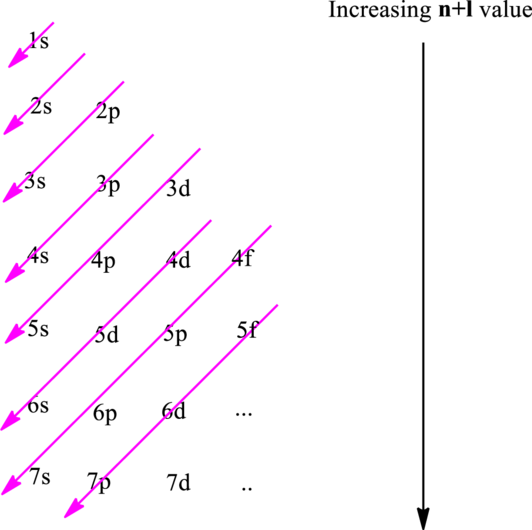
(a)
Interpretation:
The
Concept Introduction:
The fundamental principles that are followed to write an electronic configuration include three rules as follows:
Electron in a

Hund’s rule suggests electrons are not allowed to be paired up until each degenerate set of orbital has got at least one electron.
Pauli Exclusion Principle states two electrons within the same orbital cannot possess same set for four possible quantum numbers. Quantum-mechanical equivalent for this state means that two electrons are not allowed to have the same space simultaneously. Since one electron may certain discrete same set of n, l and m values, however, the fourth spin quantum number should be different. This provides a unique address to every electron. Since the possible magnitudes of spin can be either +1/2 or -1/2 thus at maximum two electrons can occupy any given orbital.
The convention followed to remove or add electrons is electrons of largest principal quantum number are lost first. In case of subshells of the same
(b)
Interpretation:
The
Concept Introduction:
Refer to part (a).
(c)
Interpretation:
The
Concept Introduction:
Refer to part (a).
(d)
Interpretation:
The
Concept Introduction:
Refer to part (a).
Want to see the full answer?
Check out a sample textbook solution
Chapter 2 Solutions
CHEMICAL PRINCIPLES (LL) W/ACCESS
- Define the following phenomena with reference to main group compounds: (d) multicenter electron deficient bondingarrow_forwardWrite the electron configuration for each of the following ions and determine which one possess noble-gas configurations: (a) Sr2+; (b) Ti2+; (c) Se2-; (d) Ni2+; (e) Br-; (f) Mn3+.arrow_forwardWhich member of each pair has more covalentcharacter inits bonds: (a) LiCl or KCl; (b) AlCl₃ or PCl₃; (c) NCl₃ or AsCl₃?arrow_forward
- Three biologically Important diatomic species,either because they promote or inhibit life, are (a) CO, (b) NO, and (c) CN−. The first binds to hemoglobin, the second is a chemical messenger, and the third interrupts the respiratory electron transfer chain. Their biochemical action is a reflection of their orbital structure. Deduce their ground-state electron configurations using sigma and pi. (Draw MO)arrow_forward5.) Electron Configurations for Ions: Supply the ground state electron configurations for the following ions. You many use the short-hand notation (e.g. Na*: [He]2s 2p°). (a) N (b) Mg*. (c) O (d) Sc* (e) Sn2+ (f) Ar 6.) Formulas of Ions: Predict the formulas of the most stable ions of the following elements (a) Na (b) Mg (c) S (d) Al (e) Br (f) Parrow_forward[Ne]3s²3p* is the noble gas configuration of oxygen O Sulphur O nitrogen carbonarrow_forward
- What is the ground state electron configuration of a Co²+ ion? O1s22s22p 3s³3p64s²3d5 O 1s22s²2p 3s³3p63d7 O 1s22s22p 3s 3p 4s²3d7 O1s²2s22p 3s³3p64s¹3d6arrow_forward4. Write an appropriate set of four quantum numbers (n, l, ml & ms) that could be representative of a valence electron in each of the following atoms or ions. (a) Bi (m (b) Sr (c) Mo (d) Ru2+ (e) Euarrow_forwardWrite electron configurations for the following ions, anddetermine which have noble-gas configurations: (a) Cd2+,(b) P3-, (c) Zr4+, (d) Ru3+, (e) As3-, (f) Ag+.arrow_forward
- Write the electron configurations for the following ions, anddetermine which have noble-gas configurations: (a) Co2+ ,(b) Sn2+ , (c) Zr4+ , (d) Ag+, (e) S2- .arrow_forwardN2 and CN' are both isoelectronic. (i) Draw the molecular orbital diagram for N2 and CN molecules. (ii) Explain why CN is a toxic substance but N2 isn't. (iii) N2(g) is an inert gas that is suitable for a wide range of application. Would you expect N2" to be a stable diatomic species in the gaseous state? Explain your answer.arrow_forwardDetermine the average Cl-F bond energy, in units of kJ mol¯, in CIF5, using t following data: • Cl2(g) + 5 F2(g) → 2 CIF5(g) A,H° = -477 kJ mol-1 159 kJ mol-1 • bond energy F-F: • bond energy Cl-Cl: 243 kJ mol-1arrow_forward
 Principles of Modern ChemistryChemistryISBN:9781305079113Author:David W. Oxtoby, H. Pat Gillis, Laurie J. ButlerPublisher:Cengage Learning
Principles of Modern ChemistryChemistryISBN:9781305079113Author:David W. Oxtoby, H. Pat Gillis, Laurie J. ButlerPublisher:Cengage Learning General Chemistry - Standalone book (MindTap Cour...ChemistryISBN:9781305580343Author:Steven D. Gammon, Ebbing, Darrell Ebbing, Steven D., Darrell; Gammon, Darrell Ebbing; Steven D. Gammon, Darrell D.; Gammon, Ebbing; Steven D. Gammon; DarrellPublisher:Cengage Learning
General Chemistry - Standalone book (MindTap Cour...ChemistryISBN:9781305580343Author:Steven D. Gammon, Ebbing, Darrell Ebbing, Steven D., Darrell; Gammon, Darrell Ebbing; Steven D. Gammon, Darrell D.; Gammon, Ebbing; Steven D. Gammon; DarrellPublisher:Cengage Learning

